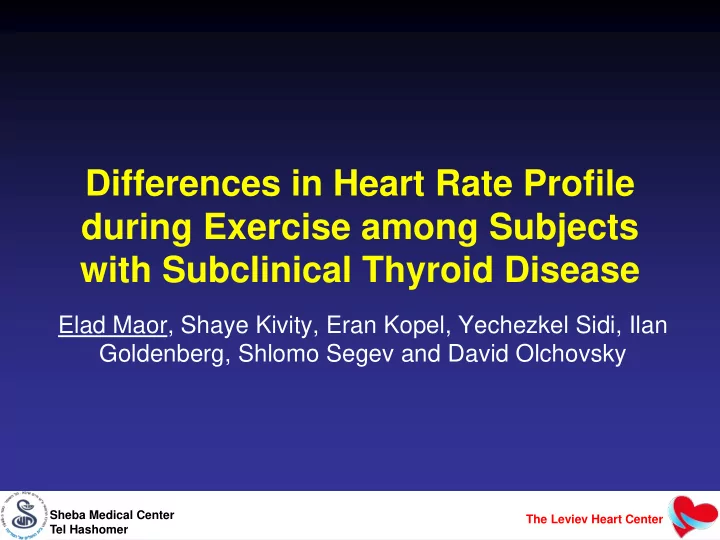

Differences in Heart Rate Profile during Exercise among Subjects with Subclinical Thyroid Disease Elad Maor, Shaye Kivity, Eran Kopel, Yechezkel Sidi, Ilan Goldenberg, Shlomo Segev and David Olchovsky Sheba Medical Center The Leviev Heart Center Tel Hashomer
Conflict of interest • none Sheba Medical Center The Leviev Heart Center Tel Hashomer
Study Hypothesis and Aim • Hypothesis: – Subclinical thyroid disease is associated with changes in heart rate profile among healthy subjects • Aim: – Evaluate heart rate profile of asymptomatic and apparently healthy patients with SCTD during routine exercise stress tests. Sheba Medical Center The Leviev Heart Center Tel Hashomer
Study population: Annual screenings of healthy subjects • Inclusion criteria: – Complete thyroid function tests (TSH FT3 FT4) at first visit – Maximal treadmill exercise (Bruce protocol) at first visit • Exclusion criteria included: – known or suspected thyroid disease – extreme TSH levels (above 10 or below 0.03 mIU/Liter) – the use of thyroid related drugs • The final study sample included 3,799 patients : – 3,456 (91%) normal thyroid function tests – 70 (1.8%) patients had subclinical hyperthyroidism – 273 (7.2%) patients had subclinical hypothyroidism Sheba Medical Center The Leviev Heart Center Tel Hashomer
Results (propensity score matching) SCHyperT Normal matched P value SCHypoT (N=273) Normal matched P value (N=70) (N=140) (N=273) Resting Heart rate (bpm) 83±17 76±12 0.006 76±13 77±15 0.091 Exercise duration (minutes) 537±126 567±166 0.179 549±169 545±156 0.786 Maximal heart rate (bpm) 163±15 163±15 0.655 158±18 159±17 0.357 Heart rate response (% of expected) 96.4±10.8 95.4±5.3 0.382 94.1±7.2 94.7±6.3 0.380 Systolic BP at maximal exercise 161±22 164±26 0.504 166±24 165±24 0.707 Diastolic BP at maximal exercise 77±9 76±9 0.450 77±10 77±10 0.831 METS 10.8±2.1 11.2±2.8 0.342 11±2.6 10.9±2.6 0.859 Recovery heart rate (bpm) 94±12 90±12 0.045 88±12 90±13 0.035 Recovery systolic BP 121±14 121±14 0.791 125±17 124±18 0.931 Recovery diastolic BP 73±7 74±8 0.847 75±9 75±8 0.691 Heart rate reserve 82±20 82±19 0.637 80±20 87±18 0.006 Sheba Medical Center The Leviev Heart Center Tel Hashomer
Conclusions Healthy subjects with subclinical thyroid disease have a significantly different heart rate profile during rest exercise and recovery. Subclinical hyperthyroidism patients had: higher resting heart rate lower heart rate reserve higher heart rate during recovery all three parameters are correlated with adverse cardiovascular outcome. Therefore, careful observation is warranted in this population Sheba Medical Center The Leviev Heart Center Tel Hashomer
Recommend
More recommend